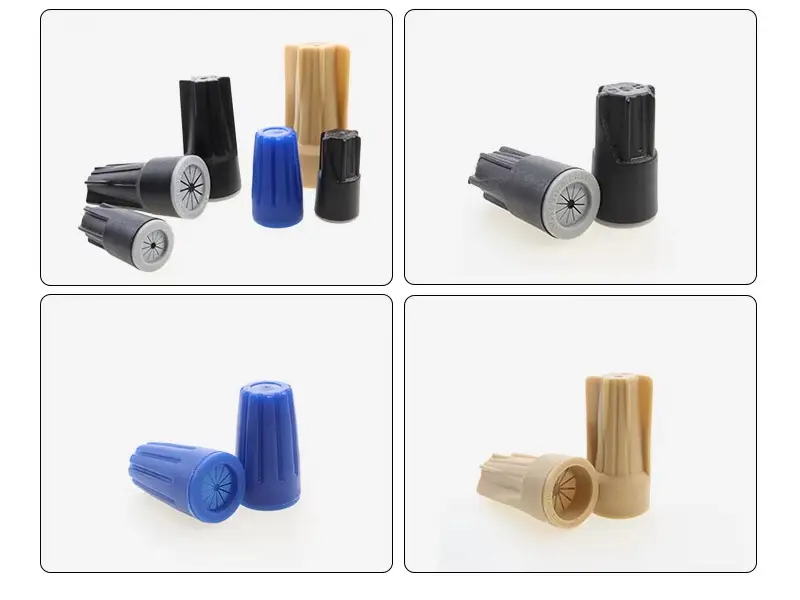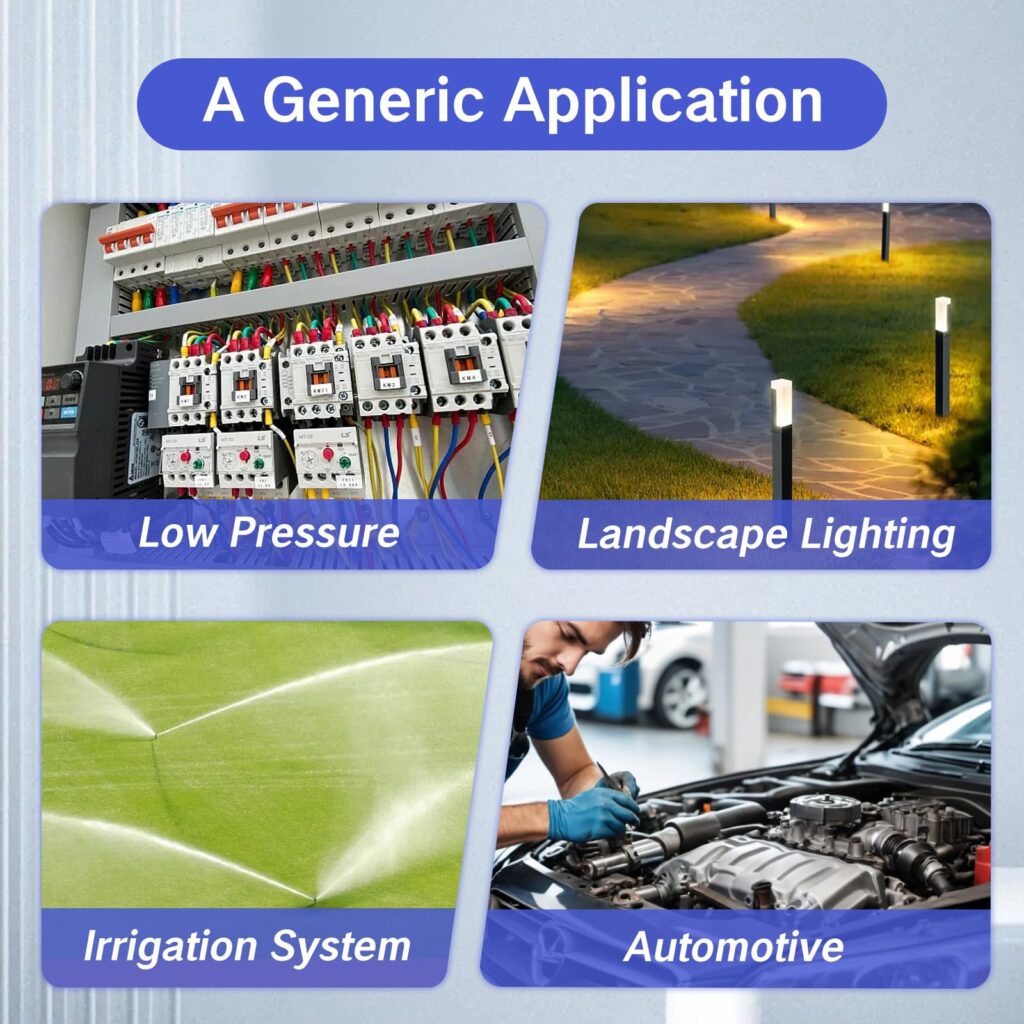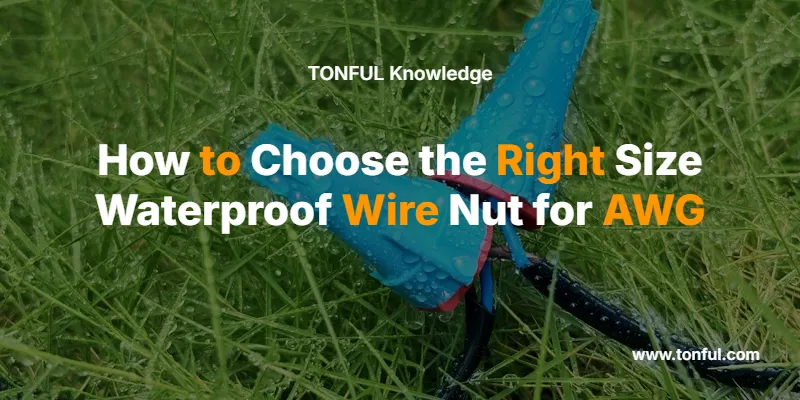Quick Answer: To choose the right waterproof wire nut size for AWG, count the total number of wires you’re connecting and note their gauge (AWG). Match this combination to the manufacturer’s capacity chart—typically, you’ll use a small connector (yellow/red) for 14-22 AWG wires, medium (blue/orange) for 12-18 AWG, and large (gray/tan) for 10-14 AWG. Always verify the specific wire combination falls within the connector’s rated capacity and meets NEC code requirements.
Understanding how to properly size waterproof wire nuts ensures safe, code-compliant electrical connections that won’t fail in wet environments. The wrong size can lead to loose connections, arcing, overheating, or moisture intrusion—all serious electrical hazards.
What Are Waterproof Wire Nuts?

Waterproof wire nuts (also called silicone-filled wire connectors or gel-filled wire nuts) are twist-on wire connectors filled with a waterproof sealant compound. You twist them onto stripped wire ends to create secure electrical connections protected from moisture, corrosion, and environmental contamination.
Key Features:
- Silicone or dielectric gel filling that seals out moisture
- Color-coded sizing for easy identification
- UL Listed for safety compliance
- Rated for direct burial, outdoor, and wet location applications
- Temperature resistant from -40°F to 221°F typically
Understanding AWG (American Wire Gauge)
AWG is the standardized wire thickness measurement system used in North America. The gauge number works inversely—smaller numbers mean thicker wire, larger numbers mean thinner wire.
Common AWG Sizes in Residential/Commercial:
- 10 AWG: 30-amp circuits (water heaters, dryers)
- 12 AWG: 20-amp circuits (kitchen outlets, bathrooms)
- 14 AWG: 15-amp circuits (lighting, general outlets)
- 16-22 AWG: Low voltage, thermostats, doorbells, landscape lighting
Waterproof Wire Nut Size Chart: Complete Comparison
Here is a table that shows the standard waterproof wire nut sizes matched to AWG wire combinations:
| Color Code | Wire Range | Max Wire Combo | Typical Applications | NEC Article |
|---|---|---|---|---|
| Yellow | 22-16 AWG | (2) 16 AWG or (3) 18 AWG | Landscape lighting, thermostats, low-voltage circuits | 110.14(C) |
| Red | 18-14 AWG | (2) 14 AWG or (3) 16 AWG | Doorbell wiring, outdoor sensors, small fixtures | 110.14(C) |
| Blue/Orange | 16-12 AWG | (2-3) 12 AWG or (4) 14 AWG | Outdoor outlets, GFCI circuits, general lighting | 110.14(A) |
| Gray | 14-10 AWG | (2-3) 10 AWG or (4) 12 AWG | Water heaters, sub-panels, large appliances | 110.14(A) |
| Tan/Large | 12-6 AWG | (2) 6 AWG or (3) 8 AWG | Service entrances, sub-feeds, heavy equipment | 110.14(C)(1) |
⚠️ SAFETY WARNING: Always verify your specific wire combination against the manufacturer’s capacity chart printed on the connector package. Different brands may have slight variations in capacity ratings.
Key Differences: Waterproof vs. Standard Wire Nuts
Here is a table that shows how waterproof wire nuts differ from standard wire connectors:
| Feature | Waterproof Wire Nuts | Standard Wire Nuts |
|---|---|---|
| Moisture Protection | Silicone/gel sealed, rated for wet locations | No seal, dry locations only |
| Cost | $0.50-$2.00 each | $0.05-$0.25 each |
| Installation | Must ensure gel fills connection | Standard twist-on |
| NEC Compliance | Meets 300.5(B) for direct burial | Indoor use only (Article 300.3) |
| Reusability | Single use (gel contaminates) | Can be reused if intact |
| Temperature Range | -40°F to 221°F | 105°F typical max |
| Applications | Outdoor, underground, wet boxes | Indoor junction boxes only |
How to Choose the Right Size: Step-by-Step Selection Process
Follow this systematic approach to select the correct waterproof wire nut:
Step 1: Identify Your Wire Gauge
Strip back the wire insulation and look for the AWG marking printed on the cable jacket. Common markings include “14/2 WITH GROUND” or “12/3 AWG.” The first number is your gauge.
Step 2: Count Your Wires
Count the total number of wires you’ll connect together, including:
- All circuit conductors of the same type (hot to hot, neutral to neutral)
- Ground wires if connecting them with wire nuts (though grounding pigtails are preferred)
Step 3: Calculate Wire Combination
Write down your combination: “(Number of wires) × (Wire gauge)”
Examples:
- Connecting 3 white neutral wires of 14 AWG = (3) 14 AWG
- Connecting 2 black hot wires of 12 AWG = (2) 12 AWG
- Connecting 4 equipment ground wires of 14 AWG = (4) 14 AWG
Step 4: Match to Manufacturer Chart
Find the connector color that accommodates your specific combination. The wire nut package will list all approved combinations like:
- “Suitable for (2) 14 AWG or (3) 16 AWG”
- “Maximum capacity: (4) 12 AWG”
Step 5: Verify NEC Compliance
Ensure your selection meets:
- NEC 110.14(A): Terminals shall be identified for proper connection
- NEC 300.5: Underground installations require listed waterproof connectors
- NEC 110.3(B): Use only equipment listed for the specific application
Step 6: Purchase Extra Connectors
Buy 20-30% more than calculated to account for installation errors and future repairs.
💡 EXPERT TIP: When in doubt between two sizes, always choose the larger connector. An oversized wire nut can still make a secure connection, but an undersized one creates a dangerous loose connection.
Real-World Applications and Use Cases

Outdoor Lighting Installations
Wire Combination: (3) 14 AWG landscape lighting wires
Correct Choice: Blue or Orange waterproof wire nut (14-12 AWG range)
Why: Multiple fixture connections need moisture protection and adequate capacity for combined wire bundle
Underground Sprinkler System Wiring
Wire Combination: (2) 18 AWG valve control wires
Correct Choice: Red waterproof wire nut (18-14 AWG range)
Why: Direct burial application requires gel-filled protection; smaller gauge handles low-voltage control circuits
Outdoor Outlet Installation (GFCI)
Wire Combination: (2) 12 AWG circuit wires
Correct Choice: Blue/Orange waterproof wire nut (16-12 AWG range)
Why: Wet location rating required; 12 AWG supports 20-amp GFCI circuit per NEC 210.8
Pool Equipment Bonding
Wire Combination: (3) 10 AWG equipment bonding conductors
Correct Choice: Gray waterproof wire nut (14-10 AWG range)
Why: Must resist pool chemicals and moisture; bonding requires 10 AWG minimum per NEC 680.26
Wire Nut Capacity Reference Guide
Understanding wire fill capacity prevents dangerous overcrowding. Here is a table showing maximum wire combinations:
| Connector Size | Small Wires (18-16 AWG) | Medium Wires (14-12 AWG) | Large Wires (10-8 AWG) |
|---|---|---|---|
| Yellow | Up to 3 wires | Not rated | Not rated |
| Red | Up to 4 wires | Up to 2 wires | Not rated |
| Blue/Orange | Up to 6 wires | Up to 4 wires | Not rated |
| Gray | Not recommended | Up to 5 wires | Up to 3 wires |
| Tan | Not recommended | Up to 6 wires | Up to 4 wires |
⚠️ SAFETY WARNING: Never exceed manufacturer-rated capacity. Overstuffing wire nuts creates inadequate contact, leading to resistance heating and potential fire hazards.
What Makes Waterproof Wire Nuts Different from Standard Connectors?
Waterproof wire nuts provide critical advantages in wet environments:
Moisture Barrier Technology
The silicone gel filling creates a complete seal around each wire, preventing water intrusion at the connection point. Standard wire nuts leave gaps where moisture can enter and cause corrosion.
Corrosion Prevention
The dielectric gel coating prevents oxidation on copper conductors. You’ll find this essential in:
- Coastal environments with salt air
- Underground installations with soil moisture
- Outdoor applications exposed to rain and humidity
- Pool and spa electrical systems
Temperature Stability
Quality waterproof connectors maintain their seal from -40°F to 221°F, while standard connectors may crack or degrade in temperature extremes.
Code Compliance
NEC Article 300.5(B) specifically requires wet location rated connectors for direct burial applications. Standard wire nuts don’t meet this requirement.
Common Wire Nut Selection Mistakes to Avoid
Mistake #1: Choosing Size by Color Alone
Different manufacturers use different color codes. Always verify the AWG range printed on the package rather than relying solely on color.
Mistake #2: Mixing Wire Gauges Incorrectly
When connecting different gauge wires (like 14 AWG to 12 AWG), you must verify the specific mixed-gauge combination appears on the capacity chart.
Mistake #3: Insufficient Strip Length
Strip wires 5/8″ to 3/4″ for proper insertion. Too short won’t engage the connector spring; too long exposes bare copper outside the nut.
Mistake #4: Using Indoor Connectors Outdoors
Standard wire nuts fail code inspection in wet locations and will corrode rapidly. Only UL-listed waterproof connectors meet NEC requirements.
Mistake #5: Overtightening
Twist until snug resistance, then give one more quarter turn. Overtightening can damage wire strands and create weak points.
💡 EXPERT TIP: After installation, gently tug each wire individually. A properly sized and installed connector will hold firm without any wire movement.
Installation Best Practices
Proper Strip Length Technique:
- Measure 5/8″ from wire end
- Score insulation with wire strippers (don’t cut into copper)
- Pull insulation straight off to avoid nicking strands
- Verify all strands intact (no breakage)
Correct Twisting Method:
- Hold wires parallel with stripped ends aligned evenly
- Twist wires together clockwise 1-2 turns by hand
- Place wire nut over twisted bundle
- Twist nut clockwise firmly until resistance increases
- Give final 1/4 turn for secure seating
Verification Steps:
- Tug test each wire (should not pull out)
- Check that no bare copper is visible below nut
- Verify gel has spread to seal all wire entry points
- Confirm nut sits flush against insulation jacket
⚠️ SAFETY WARNING: Always turn off circuit breakers and verify power is off with a non-contact voltage tester before making any wire connections.
When to Call a Professional Electrician
You should hire a licensed electrician when:
Complex Installations:
- Service panel connections (50+ amp circuits)
- Mixed wire materials (aluminum to copper transitions)
- Three-phase commercial applications
- Installations requiring permit approval
Safety Concerns:
- You’re uncertain about wire gauge identification
- Circuit breaker sizes don’t match wire capacity
- Existing wiring shows damage or deterioration
- Installation involves energized circuits
Code Compliance:
- Local jurisdiction has specific waterproofing requirements
- Installation requires electrical permit and inspection
- Work involves service entrance or meter connections
💡 EXPERT TIP: Many jurisdictions require licensed electricians for outdoor electrical work. Check your local building department requirements before beginning any outdoor electrical project.
Troubleshooting Wire Nut Connection Issues
Problem: Wire Nut Won’t Stay Tight
Causes:
- Connector too large for wire combination
- Damaged or worn connector threads
- Insufficient wire strip length
- Broken wire strands reducing conductor diameter
Solutions:
- Select one size smaller connector
- Use new connector (never reuse waterproof types)
- Re-strip wires to proper 5/8″ length
- Cut back damaged wire and re-strip
Problem: Moisture Inside Junction Box
Causes:
- Standard wire nuts used instead of waterproof rated
- Gel seal not properly formed during installation
- Box not rated for wet locations
- Missing or damaged gasket on cover plate
Solutions:
- Replace with UL-listed waterproof wire nuts
- Ensure gel completely fills around wires during installation
- Upgrade to NEMA 3R or higher rated box
- Install weather-resistant cover with intact gasket
Problem: Intermittent Circuit Issues
Causes:
- Loose connection from undersized wire nut
- Corrosion on wire due to moisture intrusion
- Oxidation from heat cycling
- Inadequate wire twist before connector application
Solutions:
- Confirm proper wire nut size per capacity chart
- Clean or cut back corroded wire sections
- Use proper torque (hand-tight plus 1/4 turn)
- Pre-twist wires before applying connector
Quick Reference Selection Guide
Use this decision tree for rapid wire nut selection:
For Low-Voltage Applications (18-22 AWG):
- Landscape lighting → Yellow or Red waterproof
- Thermostat wiring → Red waterproof
- Doorbell circuits → Red waterproof
For Standard 15-Amp Circuits (14 AWG):
- 2-3 wires → Red or Blue waterproof
- 4-5 wires → Blue or Orange waterproof
- Outdoor/underground → Must use waterproof rated
For 20-Amp Circuits (12 AWG):
- 2-3 wires → Blue or Orange waterproof
- 4+ wires → Gray waterproof
- Wet locations → UL-listed waterproof required
For Heavy Appliance Circuits (10 AWG):
- 2-3 wires → Gray waterproof
- Direct burial → Tan/Large waterproof
- Always verify amperage matches circuit breaker rating
Frequently Asked Questions
Can you reuse waterproof wire nuts?
No, waterproof wire nuts are single-use connectors. Once installed, the silicone gel contaminates the wire nut threads and loses its sealing effectiveness. Always use new connectors when making repairs or modifications.
Do I need waterproof wire nuts inside a waterproof junction box?
Yes, NEC 300.5(B) requires wet-location rated connectors even when installed inside waterproof boxes. The box protects against direct water exposure, but condensation and humidity can still cause corrosion with standard wire nuts.
What happens if I use a wire nut that’s too small?
An undersized wire nut creates a loose connection with high electrical resistance, leading to heat buildup, arcing, and potential fire hazard. The connection may initially seem secure but will degrade over time as resistance heating loosens the connection further.
Can I mix different AWG wires in one connector?
Yes, but only if that specific combination appears on the manufacturer’s capacity chart. For example, “(1) 12 AWG + (2) 14 AWG” must be explicitly listed as an approved combination on the connector package.
How many ground wires can I connect with one waterproof wire nut?
Follow the same capacity guidelines as circuit conductors. For 14 AWG ground wires, a blue connector typically handles up to 4 wires. However, many electricians prefer grounding pigtails with a single connection to the main ground for better reliability.
Are waterproof wire nuts required for outdoor light fixtures?
Yes, any electrical connection exposed to weather or moisture requires wet-location rated connectors per NEC 110.11. This includes fixture connections, junction box splices, and direct burial applications.
What’s the difference between direct burial and waterproof rated?
All direct burial connectors are waterproof, but not all waterproof connectors are rated for direct burial. Direct burial rating means the connector can withstand soil pressure, moisture, temperature cycling, and extended underground exposure without degrading. Look for UL listing showing both ratings.
Can I use waterproof wire nuts indoors?
Yes, waterproof wire nuts work perfectly in dry indoor locations. They cost more than standard wire nuts, so most electricians reserve them for wet applications, but there’s no code violation using them indoors.
Professional Recommendations and Expert Tips
Electrician’s Pro Tips:
💡 Strip Length Consistency
Use a wire gauge hole on your wire strippers as a measuring guide. Insert the wire until insulation touches the stripper body, then squeeze and pull. This ensures consistent 5/8″ strip length every time.
💡 Pre-Twisting Technique
Before applying the wire nut, twist the bare wires together clockwise with lineman’s pliers. This pre-twist ensures wires don’t separate inside the connector and creates a stronger mechanical connection.
💡 Color Coding System
Mark outdoor wire nuts with permanent marker indicating circuit purpose (“Pool Pump,” “Landscape Zone 3”). This prevents confusion during future troubleshooting and maintenance.
💡 Spare Connector Storage
Keep a small parts organizer in your outdoor electrical toolkit stocked with various waterproof wire nut sizes. Having the right size immediately available prevents project delays and the temptation to use an incorrect size.
💡 Testing Verification
After making connections, use a multimeter to verify continuity through the circuit before energizing. This catches reversed connections, loose wires, and other issues before power is applied.
NEC Code Compliance Summary
Relevant National Electrical Code Articles:
NEC 110.14(A) – Terminal Connection
Connectors must be identified for the specific wire type, gauge, and number of conductors being connected.
NEC 110.14(C) – Temperature Limitations
Wire nuts must be rated for the temperature of the connected conductors. Standard rating is 105°C, but some applications require higher ratings.
NEC 300.5(B) – Wet Locations
Underground and wet location installations require weatherproof connectors listed for direct burial applications.
NEC 110.3(B) – Installation and Use
All electrical equipment must be installed and used in accordance with instructions included in the listing or labeling.
NEC 300.3 – Conductor Requirements
All conductors of the same circuit must be contained in the same raceway or cable unless specifically permitted otherwise.
⚠️ SAFETY WARNING: Always check your local jurisdiction’s electrical code amendments. Some localities have additional requirements beyond the NEC minimum standards.
Final Selection Checklist
Before purchasing waterproof wire nuts, verify:
- Wire gauge correctly identified (AWG marking on cable)
- Number of wires to be connected counted accurately
- Wire combination matches manufacturer’s capacity chart
- Connector has UL listing for wet location or direct burial
- Color code verified against package specifications (not assumed)
- Local electrical code requirements researched
- Adequate quantity purchased (with 20-30% extra)
- Proper wire strippers available (correct gauge holes)
- Non-contact voltage tester on hand for safety
- Junction box rated for outdoor/wet use if required
Conclusion: Making Safe, Code-Compliant Connections
Choosing the right size waterproof wire nut for AWG wiring comes down to three critical factors: accurate wire gauge identification, correct wire combination counting, and verification against manufacturer capacity charts. The color-coding system provides helpful guidance, but you must always confirm the specific AWG range and wire count capacity printed on the connector package.
Remember that undersized connectors create dangerous loose connections, while properly sized waterproof wire nuts deliver decades of reliable, moisture-free electrical performance. When working with outdoor electrical systems, underground wiring, or any wet location application, using UL-listed waterproof connectors isn’t just best practice—it’s required by the National Electrical Code for your safety and the safety of others.
Take the extra time to select the correct connector size, follow proper installation techniques, and verify connections before energizing circuits. When facing complex installations or uncertain about wire nut selection, consult a licensed electrician who can ensure your electrical work meets all code requirements and safety standards.
Your safety is paramount—never compromise on proper wire connector selection.

